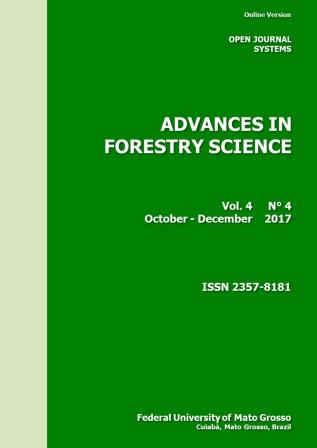Vegetative and reproductive phenology of Acacia mearnsii De Wild. in Curitiba, Paraná
DOI:
https://doi.org/10.34062/afs.v4i4.4623Palavras-chave:
Black wattle, environmental variables, correlation.Resumo
The phenology studies are fundamental to obtain information relating to plants growth and the production of fruits and seeds, making it important for forest species of commercial value, for example: for black wattle. The focus of the study was to evaluate the phenological behavior of Acacia mearnsii planted in the region of Curitiba, over 21 months, and relate the observed phenological patterns with temperature, precipitation and photoperiod. Phenological observations were conducted using the index intensity and the counting method. The phenophases were correlated with climatic variables of maximum, medium and minimum temperature, precipitation and photoperiodic using the Spearman correlation. Reproductive phenophases were observed from June to December, with peak flowering in September, and increased pod and seed in December. No significant correlation were observed in the vegetative phenophases since it was evident the constant presence of sheets at different stages throughout the study. There was no significant correlation between precipitation and phenophases. By contrast, temperature and photoperiod were negatively correlated with flowering (anthesis button)
Downloads
Referências
Boland DJ, Brooker MIH, Chippendale GM, Hall N, Hyland BPM, Johnston RD, Kleining DA, Turner JD (1984) Forest trees of Australia. Melbourne: Nelson-CSIRO, 4: 29-37.
Brun FGK, Longhi SJ, Brun EJ, Freitag AS, Schumacher MV (2007) Comportamento fenológico e efeito da poda em algumas espécies empregadas na arborização do bairro Camobi – Santa Maria, RS. Revista da Sociedade Brasileira de Arborização Urbana, 2 (1): 44-63.
Charão LS (2005) Polinização em Acácia mearnsii De Wild. Revista de Ciências Agro-Ambientais, Alta Floresta, 3:92-109.
De Paula KR (2005) Fatores Ambientais e Genéticos na Produção de Sementes de Acácia-negra. Dissertação, Setor de Ciências Agrárias, Universidade Federal do Paraná, Curitiba.
EMBRAPA (2003) Cultivo de Acácia-negra. Sistema de Produção, 3 ISSN, Versão Eletrônica.
Gaol ML, Fox JED (2002) Reproductive potential of Acacia of species in the central wheatbelt: variation between years. Conservation Science W. Aust. Australia, 4(3):147-157.
Higa RCV, Wrege MS, Mochiutti S, Mora AL, Higa AR, Simon AA (2009) Acácia-negra. In: Monteiro, J.E.B.A. Agrometeorologia dos cultivos: os fatos meteorológicos na produção agrícola. Brasília, DF: Instituto Nacional de Meteorologia, 313-319.
IBÁ (2015) Statistical yearbook, base year 2014. São Paulo, p.97. URL: http://www.iba.org/images/shared/iba_2015.pdf
Liebsch D, Mikich SB (2009) Fenologia reprodutiva de espécies vegetais da Floresta Ombrófila Mista do Paraná, Brasil. Ver.bras.Bot., 32(2), São Paulo. doi:10.1590/S0100-84042009000200016
Locatelli E, Machado IC (2004) Fenologia das Espécies Arbóreas de uma Mata Serrana (Brejo de Altitude) em Pernambuco, Nordeste do Brasil. URL: http://www.mma.gov.br/estruturas/chm/_arquivos/parte8_brejos.pdf
Machado AS, Santos AAP, Nascimento RGM (2010) Modelagem da Distribuição Diamétrica de Quatro Espécies de Lauraceae em um Fragmento de Floresta Ombrófila Mista. Ciências Exatas e Naturais, 12 (1): 91-105.
Mantovanii M, Ruschel AR, Reis MS, Puchalski A, Nodari RO (2003) Fenologia reprodutiva de espécies arbóreas em uma formação secundária da floresta atlântica. RevistaÁrvore, Viçosa-MG, 27(4):451-458.
Marques MCM, Roper JJ, Salvalaggio APB (2004) Phenological patterns among plant life forms in a Subtropical Forest in Southern Brazil. PlantEcology, Dordrecht, 173:203-213.
Martinez DT (2006) Seleção genética de AcaciamearnsiiDe Wild. (acácia-negra) visando o aumento da qualidade e produtividade de madeira e tanino no Rio Grande do Sul. Dissertação, Setor de Ciências Agrárias, Universidade Federal do Paraná, Curitiba.
Mora AL (2002) Aumento da Produção de Sementes Geneticamente Melhoradas de AcaciamearnsiiDe Wild. (acácia-negra) no Rio Grande do Sul. Tese, Setor de Ciências Agrárias, Universidade Federal do Paraná, Curitiba.
Morellato LPC, Talora DC, Takahasi A, Bencke CC, Romera VBZ (2000) Phenology of Atlantic Rain Forest Trees: A Comparative Study. Biotropica, São Paulo, Brazil, 811-823.
Resende MDV, Souza SM, HIGA AR, Stein PP (1991) Estudo da Variação Genética e Métodos de Seleção em Teste de Progêies de Acaciamearnsii no Rio Grande do Sul. Embrapa Florestas, Boletim de Pesquisa Florestal, Colombo, 23:45-59.
Resende MDV, Higa AR, Heller JB, Stein PP (1992) Parâmetros Genéticos e Interação Genotípica x Ambiente em Teste de Procedência e Progênies de Acácia-negra (Acaciamearnsii). Embrapa Florestas, Boletim de Pesquisa Florestal, Colombo, 25: 55-65.
Rondon Neto RM, Kozera C, Andrade RR, CECY AT, Hummes AP, Fritzsons E, Caldeira MVW, Maciel MNM, Souza MKF (2002) Caracterização Florística e Estrutural de um Fragmento de Floresta Ombrófila Mista, em Curitiba, PR- Brasil. Floresta, Curitiba, 32:3-16.
Stiehl-alves EM, Martins-corder MP (2006) Acaciamearnsii De Wild. (Fabaceae) reproductive biology II: flowering and fructification phenology. Crop Breding and Applied Botechnology, 6:144-150.
Van Etten, E. J. (2009). Inter-annual rainfall variability of arid Australia: greater than elsewhere? Australian Geographer, 40(1), 109-120. URL: http://www.tandfonline.com/doi/abs/10.1080/00049180802657075
Viera, M.,;Schumacher, M. V. (2010). Deposição de serapilheira e de macronutrientes em um povoamento de acácia-negra (Acacia mearnsii De Wild.) no Rio Grande do Sul. Ciência Florestal, 20(2), 225-233.
White, L. J. (1994). Patterns of fruit-fall phenology in the Lopé Reserve, Gabon. Journal of Tropical Ecology, 10(3), 289-312.

